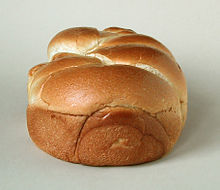
Back تفاعل ميلارد Arabic Рэакцыя Маяра Byelorussian Реакция на Маяр Bulgarian Reacció de Maillard Catalan Maillardova reakce Czech Adweithiad Maillard Welsh Maillard-reaktion Danish Maillard-Reaktion German Αντίδραση Μαϊγιάρ Greek Reacción de Maillard Spanish

The Maillard reaction (/maɪˈjɑːr/ my-YAR; French: [majaʁ]) is a chemical reaction between amino acids and reducing sugars to create melanoidins, the compounds which give browned food its distinctive flavor. Seared steaks, fried dumplings, cookies and other kinds of biscuits, breads, toasted marshmallows, and many other foods undergo this reaction. It is named after French chemist Louis Camille Maillard, who first described it in 1912 while attempting to reproduce biological protein synthesis.[1][2] The reaction is a form of non-enzymatic browning which typically proceeds rapidly from around 140 to 165 °C (280 to 330 °F). Many recipes call for an oven temperature high enough to ensure that a Maillard reaction occurs.[3] At higher temperatures, caramelization (the browning of sugars, a distinct process) and subsequently pyrolysis (final breakdown leading to burning and the development of acrid flavors) become more pronounced.[4]
The reactive carbonyl group of the sugar reacts with the nucleophilic amino group of the amino acid and forms a complex mixture of poorly characterized molecules responsible for a range of aromas and flavors. This process is accelerated in an alkaline environment (e.g., lye applied to darken pretzels; see lye roll), as the amino groups (RNH+3 → RNH2) are deprotonated, and hence have an increased nucleophilicity. This reaction is the basis for many of the flavoring industry's recipes. At high temperatures, a probable[5] carcinogen called acrylamide can form.[6] This can be discouraged by heating at a lower temperature, adding asparaginase, or injecting carbon dioxide.[5]
In the cooking process, Maillard reactions can produce hundreds of different flavor compounds depending on the chemical constituents in the food, the temperature, the cooking time, and the presence of air. These compounds, in turn, often break down to form yet more flavor compounds. Flavour scientists have used the Maillard reaction over the years to make artificial flavors, the majority of patents being related to the production of meat-like flavours.[7]
- ^ Maillard, L. C. (1912). "Action des acides amines sur les sucres; formation de melanoidines par voie méthodique" [Action of amino acids on sugars. Formation of melanoidins in a methodical way]. Comptes Rendus (in French). 154: 66–68.
- ^ Chichester, C. O., ed. (1986). Advances in Food Research. Advances in Food and Nutrition Research. Vol. 30. Boston: Academic Press. p. 79. ISBN 0-12-016430-2.
- ^ Bui, Andrew (2017-09-29). "Why So Many Recipes Call for a 350-Degree Oven". Tasting Table. Retrieved 6 November 2017.
- ^ "Here's How to Sear a Steak to Perfection". Home Cook World. 2021-09-06. Archived from the original on 2022-01-27. Retrieved 2022-01-27.
- ^ a b Tamanna, N; Mahmood, N (2015). "Food Processing and Maillard Reaction Products: Effect on Human Health and Nutrition". International Journal of Food Science. 2015: 526762. doi:10.1155/2015/526762. ISSN 2314-5765. PMC 4745522. PMID 26904661.
- ^ Tareke, E.; Rydberg, P.; Karlsson, Patrik; Eriksson, Sune; Törnqvist, Margareta (2002). "Analysis of acrylamide, a carcinogen formed in heated foodstuffs". J. Agric. Food Chem. 50 (17): 4998–5006. doi:10.1021/jf020302f. PMID 12166997.
- ^ Danehy, James P. (May 19, 1986). Chicester, C.O. (ed.). "Maillard Reactions: Nonenzymatic Browning in Food Systems with Special Reference to the Development of Flavor" (PDF). Advances in Food Research. 30. Academic Press: 107. Retrieved 15 March 2024.
© MMXXIII Rich X Search. We shall prevail. All rights reserved. Rich X Search